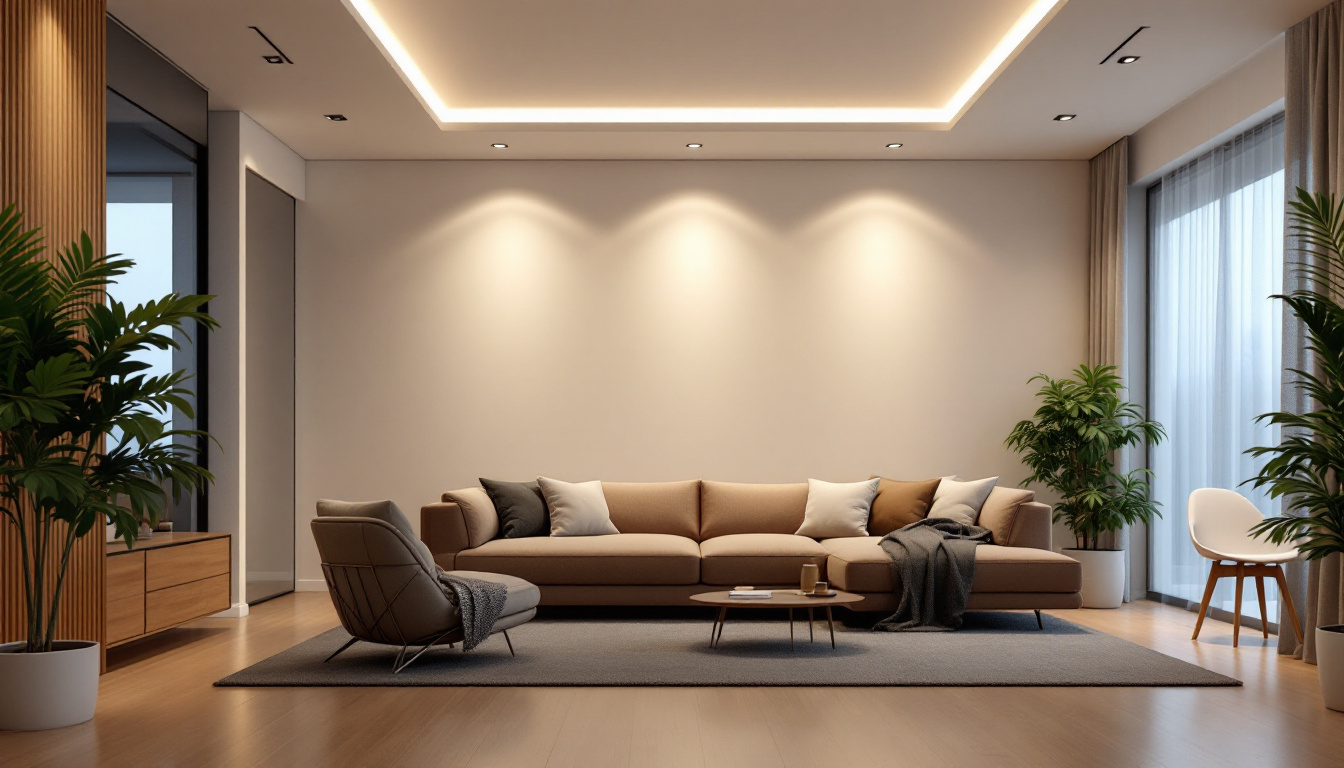

Office lighting plays a crucial role in enhancing productivity, comfort, and overall aesthetics in workspaces. As the demand for efficient and effective lighting solutions grows, lighting contractors are at the forefront of providing insights and expertise on the best practices for office ceiling lights. This article delves into various aspects of office ceiling lighting, offering valuable knowledge from industry professionals.
Effective office ceiling lighting is not merely about illuminating a space; it significantly impacts employee well-being and productivity. Research has shown that proper lighting can reduce eye strain, enhance mood, and even influence the overall performance of employees. A well-lit environment can lead to fewer mistakes, higher job satisfaction, and an overall positive workplace atmosphere, which is essential for fostering creativity and collaboration among team members.
Natural light is often considered the gold standard in office lighting. It has been linked to numerous benefits, including improved concentration and a reduction in fatigue. However, maximizing natural light can be challenging, especially in urban environments where buildings may obstruct sunlight. Lighting contractors recommend using a combination of natural and artificial lighting to create a balanced environment. Furthermore, studies have shown that exposure to natural light during working hours can lead to better sleep patterns, which in turn enhances overall health and productivity.
Incorporating large windows, skylights, or light tubes can help bring natural light into the office. Additionally, using reflective surfaces and light-colored walls can enhance the distribution of natural light throughout the space. It’s also beneficial to consider the orientation of the building; offices that face south or west typically receive more sunlight throughout the day. Integrating plants and greenery near windows can also help to create a more inviting atmosphere, as they thrive in natural light and contribute to a sense of well-being.
When selecting ceiling lights for an office, several types are available, each with its unique advantages. The most common types include recessed lighting, pendant lights, and fluorescent fixtures. Recessed lighting offers a sleek and modern look, ideal for contemporary office designs. Pendant lights, on the other hand, can serve as focal points while providing adequate illumination for specific areas. They can also be adjusted in height to suit different tasks, making them versatile choices for various office layouts.
Fluorescent fixtures are often used in commercial settings due to their energy efficiency and longevity. However, advancements in LED technology have led to the increasing popularity of LED ceiling lights, which provide excellent illumination while consuming less energy. These lights come in various color temperatures, allowing businesses to choose warmer or cooler tones to suit their branding and desired ambiance. Additionally, smart lighting systems can be integrated into office designs, enabling employees to adjust light levels according to their preferences, further enhancing comfort and productivity.
Choosing the right ceiling lighting involves several considerations to ensure that the lighting meets both functional and aesthetic requirements. Lighting contractors emphasize the importance of evaluating the specific needs of the office environment before making decisions.
Before selecting lighting fixtures, it is essential to assess the office space thoroughly. Factors such as the size of the room, the layout, and the activities performed within the space can influence the type and placement of lighting. For example, an open-plan office may require different lighting solutions compared to a conference room or a break area.
Lighting contractors often recommend conducting a lighting audit to evaluate the current lighting conditions and identify areas that require improvement. This assessment can help determine the best lighting solutions tailored to the specific needs of the space. Additionally, considering the natural light available in the office can play a crucial role in the overall lighting strategy. Offices with large windows may benefit from a combination of ambient and task lighting to complement the daylight, while spaces with limited windows might require more robust artificial lighting to maintain a bright and inviting atmosphere.
The color temperature of office ceiling lights can significantly affect the ambiance of the workspace. Measured in Kelvin (K), color temperature ranges from warm (below 3000K) to cool (above 5000K). Warm light creates a cozy atmosphere, while cool light promotes alertness and focus.
Most experts suggest using a color temperature between 3500K and 5000K for office environments, as this range strikes a balance between comfort and productivity. Additionally, the brightness of the lighting, measured in lumens, should be sufficient to illuminate the space without causing glare or discomfort. It is also important to consider the distribution of light across the office. Using a combination of direct and indirect lighting can help reduce harsh shadows and create a more evenly lit environment, which is particularly beneficial in areas where employees spend long hours working. Furthermore, incorporating dimmable fixtures can provide flexibility, allowing workers to adjust the lighting according to their tasks and preferences, thereby enhancing overall comfort and efficiency in the workplace.
As businesses increasingly prioritize sustainability, energy-efficient lighting solutions have become a focal point in office design. Lighting contractors are well-versed in the latest technologies that not only reduce energy consumption but also lower operational costs.
LED lights have revolutionized the lighting industry, offering significant advantages over traditional incandescent and fluorescent fixtures. They consume up to 80% less energy and have a much longer lifespan, reducing the need for frequent replacements and maintenance.
Moreover, LED lights are available in various styles and color temperatures, making them versatile for different office settings. Their ability to produce high-quality light while minimizing energy usage makes them an ideal choice for modern offices looking to enhance sustainability.
Advancements in technology have led to the development of smart lighting systems that allow for greater control over office lighting. These systems can be programmed to adjust brightness and color temperature based on the time of day or occupancy levels, optimizing energy usage.
Smart lighting solutions can also be integrated with other building management systems, providing a comprehensive approach to energy efficiency. Lighting contractors recommend considering these systems for larger office spaces where managing energy consumption is crucial.
Creating an effective lighting plan for an office involves a strategic approach that considers both functionality and aesthetics. Lighting contractors emphasize the importance of collaboration with architects and interior designers to achieve a cohesive design.
A layered lighting approach combines different types of lighting to create a well-balanced environment. This method typically includes ambient, task, and accent lighting. Ambient lighting provides overall illumination, while task lighting focuses on specific areas where employees perform their work, such as desks or meeting rooms. Accent lighting can highlight architectural features or artwork, adding visual interest to the space.
By employing a layered lighting strategy, contractors can ensure that the office is not only well-lit but also visually appealing. This approach can help create a more inviting atmosphere that enhances employee satisfaction and productivity.
Office lighting must comply with various regulations and standards to ensure safety and accessibility. Lighting contractors should be familiar with local building codes and guidelines, such as the Americans with Disabilities Act (ADA), which outlines requirements for lighting in commercial spaces.
Ensuring compliance with these regulations is crucial for avoiding potential legal issues and creating an inclusive environment for all employees. Contractors should work closely with clients to educate them on these requirements and incorporate them into the lighting design.
Once the office ceiling lights are installed, ongoing maintenance is essential to ensure optimal performance and longevity. Lighting contractors can provide valuable insights into the best practices for maintaining office lighting systems.
Conducting regular inspections of lighting fixtures can help identify issues before they become significant problems. Contractors recommend checking for burnt-out bulbs, flickering lights, or any signs of electrical issues. Addressing these problems promptly can prevent disruptions in the workplace and ensure a consistently well-lit environment.
Additionally, cleaning fixtures and replacing filters in lighting systems can enhance efficiency and prolong the lifespan of the equipment. Regular maintenance can also improve the quality of light, contributing to a more pleasant workspace.
As technology advances, upgrading lighting systems can provide numerous benefits, including improved energy efficiency and enhanced functionality. Lighting contractors should stay informed about the latest innovations in lighting technology and recommend upgrades when appropriate.
For example, transitioning to smart lighting systems or replacing outdated fixtures with energy-efficient LEDs can significantly reduce operational costs and improve the overall lighting experience in the office.
Office ceiling lighting is a critical component of creating an effective and inviting workspace. By understanding the importance of proper lighting, considering key factors in the selection process, and implementing best practices for maintenance, lighting contractors can significantly enhance the quality of office environments.
As the landscape of office design continues to evolve, staying informed about the latest trends and technologies in lighting will be essential for contractors. By leveraging their expertise, they can provide clients with innovative solutions that not only meet their needs but also contribute to a sustainable and productive workplace.
Ultimately, the insights shared by expert lighting contractors can pave the way for transformative office spaces that prioritize employee well-being and operational efficiency. Investing in quality ceiling lighting is not just a matter of aesthetics; it is a strategic decision that can yield long-term benefits for businesses and their employees.
Ready to elevate your office lighting projects with the best in spec-grade lighting products? Look no further than LumenWholesale, where we provide contractors with superior lighting solutions at unbeatable wholesale prices. Our commitment to quality, affordability, and convenience ensures that you get the most reliable and high-performance lighting without the burden of inflated markups or hidden fees. Plus, with free shipping on bulk orders, you can stock up on premium lighting effortlessly. Don’t compromise on your lighting needs—choose LumenWholesale for the perfect blend of quality and value. Wholesale Lighting at the Best Value is just a click away.

Discover the essential insights every lighting contractor needs to know about recess lights.

Discover the essential insights lighting contractors need about LED corn lights.

Discover the essential guide for lighting contractors on LED light coverings.

Discover how industrial LED technology is revolutionizing the lighting industry by boosting efficiency for contractors.
Get notified when NEW deals are released.
Optimize your budget with wholesale discounts.
Only top-quality, specification-grade lighting products.
No additional costs at checkout - what you see is what you pay.
We understand the unique needs of contractors.